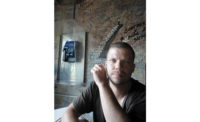
Eric Cesal is the new executive director of Architecture for Humanity (AFH), the nonprofit’s board of directors announced today. A longtime volunteer, Cesal joined AFH full-time in 2010 to start the Haiti Rebuilding Center in Port-au-Prince. Since 2012 he has led the organization’s global post-disaster rebuilding efforts from its headquarters in San Francisco. Cesal replaces founding executive director Cameron Sinclair, who, with cofounder Kate Stohr, announced their resignation last fall.
 |
| Photo courtesy Architecture for Humanity Eric Cesal, right, in Haiti. |
In 1999, when Sinclair and Stohr launched AFH with a design competition for temporary housing for Kosovo war refugees, the idea of the architect as a disaster responder was fringy at best. Fifteen years later, AFH encompasses 59 chapters in sixteen countries, and design thinking frequently claims a place in the early stages of rebuilding.
But after years of seeing crises up close, Cesal and his colleagues began to grasp that when they arrive at a disaster, they’re already too late. “Philosophically, we’ve come to a point where we cannot separate our responsibility of responding to a crisis from our responsibility of preventing it,” says Cesal, who holds master’s degrees in architecture, construction management, and business administration from Washington University in St. Louis. “Over the next fifteen years, Architecture for Humanity is going to devote a lot of its attention to resilience—I hate that word—by working with architects and cities to anticipate the hazards that are brought about by climate change, mass urbanization, and poor construction, and remediate them before disasters happen.”
On the phone from Kigali, Rwanda, where he was visiting AFH’s Kimisagara Football for Hope Centre, Cesal discussed the changing role of the architect, what’s next for Architecture for Humanity, and his beef with the word “resilience.”
Do the frequency and seriousness of the crises we’re facing demand a change in the role of the architect?
The role of the architect either has to evolve seriously or go away. For the first time in history, we’re going to have more people living in cities than not. At the same time, climate change is creating problems; 70 percent of our urban population lives on the water. If architects want to play a meaningful part, they have to look at these issues.
Why do you hate the world “resilience”?
It’s becoming one of those words that everybody has a different definition for. It took us many years to come to a mutually agreeable definition of sustainability, and we’re still kind of arguing about it.
What do you mean when you say “resilience”?
The typical definition defines resilience as the ability to absorb shocks, and I don’t think that’s what we want for our cities. How do we start thinking about our cities—not only the physical buildings but also the legal and economic infrastructure that supports them—in a way that allows them to grow and strengthen from the unknown, rather than trying to wall ourselves off from increasingly unpredictable natural phenomena?
Given that you don’t know where disaster will strike, how do you begin to try to get in front of the problem?
You’ve got to start somewhere. Hurricanes and earthquakes are not preventable, but a disaster occurs when a natural phenomenon interacts with a built environment in a way that poses hazards and endangers human lives and property. If we acquiesce to the idea that disasters are just going to happen and there’s no reason to invest in improvements to our built environment, then yes, it’s an insurmountable problem and we shouldn’t worry about it. But that would be like saying, “Well, a measles outbreak is going to occur eventually, so there’s no point in inoculating our children.”
Any ideas about how to improve resilience or what can help us think it through?
Dialogue without vanity. Because of the mechanics of success in architecture, there’s often a pressure to create solutions you can market as something different from what everyone else is doing. The principal value Architecture for Humanity can create is to bring together all kinds of designers, academics, and politicians and say, “Hey, let’s figure out what exactly this looks like.” There’s not one of us who’s smarter than all of us.


Post a comment to this article
Report Abusive Comment